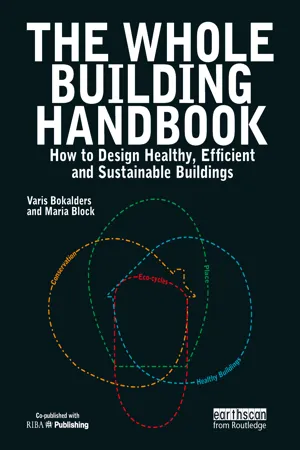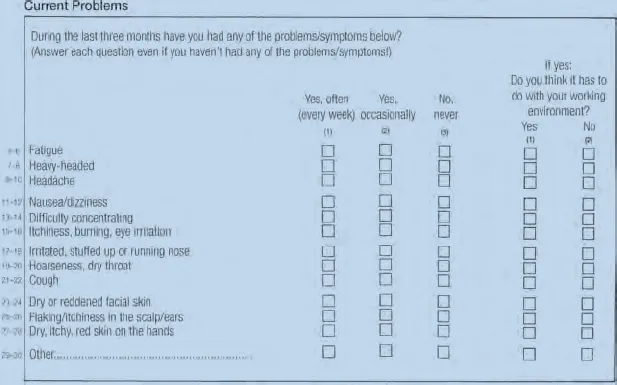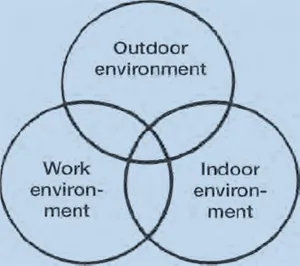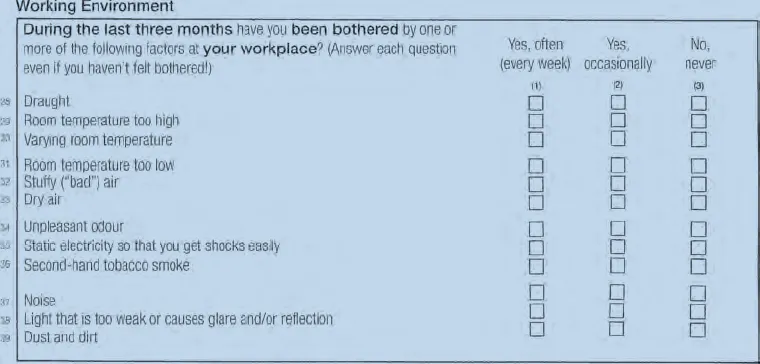![]()
A building influences the well-being of those who spend time in it. A building can be called the third layer of skin, and clothes are the second.
Source: De siste syke hus (The Last Sick Buildings), Björn Berge, 1988
Building Healthy Buildings
Building healthy buildings deals primarily with the interior environment, i.e. how to construct buildings that people feel good in, but also how to do so without adverse effects on construction workers and the environment. In some climates people spend more than 90 per cent of their time indoors. This means, of course, that people are highly influenced by the buildings they live and work in. This concept can be compared with the kind of clothes we wear and how their characteristics greatly influence us and our well-being.
Healthy Construction Materials –
Choosing Materials From Environmental and Health Viewpoints
Construction materials are described here according to their chemical content and their influence on the environment from a life-cycle perspective. A general assessment is given of materials that have the least impact on environment and health.
Supply –
Choosing Services for Ventilation, Electricity and Water
Which supply options should be chosen to get a comfortable interior climate with pleasant warmth and low electromagnetic fields, and how can a building be protected from water damage? How should ventilation, electricity and pipework systems be designed?
Design –
Choosing Good Design for Resource Conservation and Well-being
Even with healthy materials and good supply systems, things can go wrong if the design isn’t right. How can problems with moisture, radon and noise be avoided? How can building design achieve ease of cleaning and maintenance?
Implementation –
How the Chosen Environmental Aims are Achieved
Building sustainably requires new knowledge, better coordination and environmental management so that consideration for the environment is not lost along the way. New routines are needed at construction sites, together with a different attitude to construction waste.
Questionnaire for surveying peoples’ experience of the interior climate.
Source: Örebro Länslasarett (County Hospital), Kjell Andersson et al
Environmental Impact of Building Materials
Choosing the right material from an ecological perspective is not always easy since there are many factors to take into consideration. Important aspects are how materials influence the interior climate (and so the people who spend time there); how materials impact the outdoor environment in general; and how plants and animals are influenced by the discharges caused by the production and disposal of such materials. Furthermore, there is also the issue of the working environment for all those who work producing materials, and undertaking construction and demolition.
Sick Buildings
There has been debate about sick building syndrome (SBS) since the 1980s. The number of sick buildings has increased with time. It is important to try and understand the causes of sick building syndrome so that they can be avoided in future. About 10–30 per cent of modern buildings may cause SBS. Those who spend time in these buildings show one or more of the following symptoms: eyes/nose/throat irritation, throat infections, sinus infections, a feeling of dryness in mucous membranes, dry lips and skin, itchy face and scalp, skin redness, eczema, fatigue, lack of concentration, nausea, headaches and allergy problems.
It is not possible to confirm that a building is sick by using technical measurements. Peoples’ experiences and problems are used as the basis for judgements. At Örebro County Hospital (Kjell Andersson, et al) a suitable interview model has been developed to determine whether a building can be regarded as sick. First, people fill in a specially formulated questionnaire about their experiences of the interior climate. Then the answers are presented graphically in ‘roses’, one for environmental factors and one for problems and symptoms experienced.
When choosing materials from an environmental point of view, it is important to weigh up a material’s impact on the outdoor environment together with its impact on the interior environment (the health of users), as well as on the working environment.
Causes of Sick Buildings
Much is known about why buildings make people sick or cause difficulties:
• poor materials (release of chemical emissions, fibres or allergens);
• poor ventilation (relative humidity, temperature, odours);
• moisture problems (poor construction, carelessness, insufficient drying times, etc.);
• electric and magnetic fields (wiring, appliances, metal, etc.);
• problems with the ground (radon, moisture);
• disturbance from the surrounding environment (traffic, noise, air pollution, etc.);
• inappropriate use (use of chemicals, more showering than a waterproof area can handle, smoking);
• insufficient cleaning and maintenance;
• lack of comfort;
• lack of architectural attractiveness.
The results from an interview survey of a suspected sick building are compiled in ‘rose’ figures.
Source: Örebro County Hospital, Kjell Andersson et al
This figure shows examples of construction materials chosen by the municipal housing company in Vadstena. Buildings are made of solid lightweight concrete, insulated with cellular glass in the foundation under a concrete slab and with cellulose fibre in the loft. Floors are made of wood and interior walls of gypsum. Clay tiles are used on the roof and limestone is used for the window sills. Bathrooms have tile and expanded clay surfaces. Interior wooden partitions have solid wood frames covered with hardboard. Coconut fibre is used for packing around the windows.
1.1 Materials and Construction Methods
It is difficult to choose the right material since a lot of knowledge is required. For example, knowledge of chemistry is needed since chemicals influence health and the ecosystem. Furthermore, information is needed about resource consumption and the environmental impact of materials in production and use. The environmental impact of a material from cradle to grave can be measured using life-cycle analysis (LCA) and reported in the form of an environmental profile. Some analysts study materials from cradle to cradle, as nothing should be wasted in a sustainable society. The next problem is to consider all the facts and make a judgement. It is a matter of understanding how a material influences the interior environment and the health of users, how management of the material influences the health of construction workers, as well as how use of the material impacts the ecosystem.
1.1.0 Selection of Materials
In order to evaluate a material it is necessary to know what it contains, how it is made, the quantity of resources used, the emissions released, how much and what kind of energy is used in production and transport, and what the resulting residues are. This means that access to product information documentation (environmental declarations) is required. This can be difficult to obtain and is not always complete. Similar materials may have different contents and different production processes. In order to make a good environmental choice, it is not enough to know the impact of a material type, the impact of the specific product must be to hand.
Construction Material Specifications
The specification of a construction material should include the following:
• material name, short description and area of use;
• producer and supplier and their environmental policies and environmental management systems;
• declaration of ingredients, noting any recognized hazardous substances and environmental labelling.
1 Input materials – resource consumption: Raw materials and additives and in what amounts. Emissions to air, water and land. Creation of hazardous waste. Are recycled materials included? The sum total of energy used (raw and recycled materials). Source and method of transporting raw materials/ingredients. Type of energy source used (renewable or non-renewable).
2 Production – production process: Type of energy source, energy consumption, energy quality, emissions to air, water and land. Are residual products created, and if so are they used in other production? Is hazardous waste created?
3 Distribution – finished construction material: Production location/country, method of transport, forms of distribution, type of packaging, does the producer take back the packaging material?
4 Construction phase – building process: The need for equipment and machines. Document the need for consumable supplies for the building process. Emissions to air, water and land. Are hazardous wastes created? Are there any customized materials? Are leftover materials taken back?
5 Use phase – operation, maintenance: Operation, energy source, materials necessary to maintain function and characteristics during the use phase (e.g. cleaning compounds and lubrication oil). Maintenance (surface treatment, filters, parts that wear out, etc.). Life.
6 Demolition – dismantling: Ease of dismantling. Does the product require special measures for protection of health and the environment?
7 Residual products – reuse, recycling: Can the residual products be reused, the material recycled or energy extracted from it? Emissions during combustion?
8 Waste products – dumping: Emissions to air, water and land during dumping. Should the waste be managed according to h...






